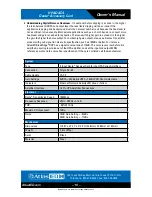
Owner’s Manual
HPA-DAC4
Dante
®
Accessory Card
AtlasIED.com
– 10 –
Specifications are subject to change without notice.
1601 Jack McKay Blvd. • Ennis, Texas 75119 U.S.A.
Telephone: 800.876.3333 • Fax: 800.765.3435
6.
Understanding Digital Noise vs Headroom
- If headroom before clipping is a concern, the higher
the ratio between OdBFS and output level, the less likely clipping will be an issue. If the
application is paging and background music then a lower number is ok because the headroom is
not as critical. In live sound reinforcement applications such as a church band or a concert, more
headroom and gain is needed for dynamics. The issue with higher gain in a product is the higher
the gain the higher the noise output. To combat high gain output noise, use a Dante
®
Transmitter
product with good signal to noise ratio specification, such as 100dB or better. For instance,
AtlasIED BlueBridge
®
DSP has a signal to noise ratio of 110dB. The noise is very low before it is
amplified, assuring low noise out of the HPA amplifier. Look at the input and output 0dBFs
reference points and the noise floor specification. If they are not listed call the manufacturer.
System
Type
4 Input Dante
®
Receiver Card for the HPA Series Amplifiers
Connection
Single RJ-45
Cable Quality
CAT-5
Gain Settings
0dBFS = 20dBu & 0dBFS = 10dBu PCB Shunt Selectable
Indicators
Ethernet Network Activity LED Green / Yellow
Amplifier Interface
16 Pin HPA Amplifier Connections
Electrical
Dante
®
Transmission Speed
100Mbps
Frequency Response
20Hz - 20KHz +/- 1dB
THD
.06% @ 1KHz
Maximum Output Level
7dBu
Noise
10dB Gain Setting = -83dBu
20dB Gain Setting = -77dBu
Mechanical
Dimensions
H 0.97" x W 2.7" x D 2.5" (H 24.6mm x W 68mm x D 63mm)
Weight
2.6oz (.07kg)
Color
Black
Material
Steel






























